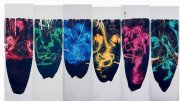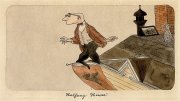During the past few decades, colorful abstractions by Ellen Carey have exemplified the Greek origins of the word photography—pho-s for light, graphis for drawing. “I capture light working with film and chemistry” while mining the materiality of the medium, says the Hartford, Connecticut-based artist. That means no gorgeous landscapes, representational portraits, or candid street scenes. She’s not interested in documenting a given reality. Instead, her work shares more with surrealism and abstract expressionism—and even fine art, painterly traditions. Her series of large-scale photographs can resemble neon-lit astronomical maps or laser art shows on paper, while other images offer a lustrous rainbow blend of shades, yet all are created in the darkroom.
See the spectrum of her pioneering creativity in Ellen Carey: Struck by Light, at the New Britain Museum of American Art through January 28. This largest survey to date of her photograms and lens-based prints includes her 2022 Crush & Pull with Hands & Penlights. Using a huge Polaroid 20x24 instant camera (only six were ever built), she produces the prints—and includes the purposely marred negatives—that reflect black space, spooling lightning flashes of color, and amorphous forms with darting hands. By contrast, her 2013 color photogram Dings & Shadows is a velvety burst of saturated hues produced by beaming randomly folding photographic paper (which introduces the desired accidental-design features) with colored bulbs at various angles. At root, Carey explores the “genesis or DNA of photography as an experimental medium,” pushing the limits of equipment, supplies, science, and chemicals. “Most people use photography as a tool to see themselves and the world,” she says. For her, the art is framed by what she can do, what she can play with, in the world of her studio. “Light’s immateriality challenges us,” she says, “but light offers everything: it travels, makes silhouettes, outlines, shadows—so light is our world.”









